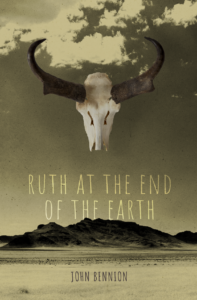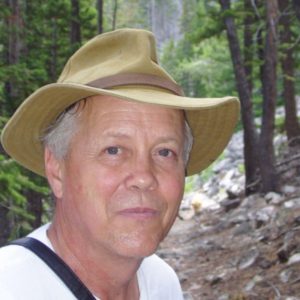John Bennion introduces his new novel, Ruth at the End of the Earth (BCC Press)
 It’s probably not news to anyone who has read any my fiction or essays that I write primarily about Mormon-culture communities living in the arid country of the eastern Great Basin. Ruth at the End of the Earth is no exception, except that it’s set in 2135, a little over a century in the future. Writing it, I wanted to imagine how people would survive in a land that was already hot and dry long before anthropomorphic climate disruption weighed in. I’ve long admired the knowledge and cleverness of the Goshutes, who inhabited the high basin where I grew up, Rush Valley, and the next one to the west, Skull Valley. Ruth, my protagonist, learned what she knows about survival from her Goshute, Mexican, and Mormon ancestors.
It’s probably not news to anyone who has read any my fiction or essays that I write primarily about Mormon-culture communities living in the arid country of the eastern Great Basin. Ruth at the End of the Earth is no exception, except that it’s set in 2135, a little over a century in the future. Writing it, I wanted to imagine how people would survive in a land that was already hot and dry long before anthropomorphic climate disruption weighed in. I’ve long admired the knowledge and cleverness of the Goshutes, who inhabited the high basin where I grew up, Rush Valley, and the next one to the west, Skull Valley. Ruth, my protagonist, learned what she knows about survival from her Goshute, Mexican, and Mormon ancestors.
A desert woman of six decades, Ruth knows how to scoop up an ant hill and separate food from pebbles by spinning the basin, how to skin a prickly pear and suck the pulp, and to pluck grubs from the family compost pit and clean them with sand. She can outwait a kangaroo rat and snag him up when he finally dares leave his hole. She can smell water from a mile away, knows just where to strike a man with her huupita to incapacitate or kill him, and can use the same stick to dig a hole for herself for shelter from the sun. As you can tell, I’m smitten.
One inheritance from Ruth’s ancestors is to mistrust anything you can’t make with your own hands, because manufactured tools and clothing require industry for extracting the materials, making the object, transporting it to the user, and disposing of it when it breaks or wears out. If she knew how to read, she would be a disciple of Wendell Berry, current-day prophet of subsistence living. Another inheritance is her powerful bond to her near and distant relatives, including those who are dead. They still walk the earth and communicate to those living people who will listen.
The story centers on the relationship between Ruth and Benson, a stranger who comes to the Family cave. She has the strong premonition that his knowledge and experience might be more valuable to the Family’s survival than the water in his blood. After saving his life, she sets off with him into the desert, hoping to keep him alive long enough to discover what he knows. What begins as Ruth’s impulse to save herself and those who live with her in the cave ends in a journey to the walled city of Salt Lake and to the ocean near where San Francisco now exists. She faces a harrowing choice that will either extend the life of the Family (and possibly the earth) or destroy what little hope remains for humanity’s survival. If that last bit sounded like an elevator pitch, give yourself ten points.
The personal is the universal, and I hope that Ruth and Benson’s differences and the decisions they make raise issues we are already facing as earth’s climate becomes more and more disrupted. Benson grew up in the city where people possess their own space to isolate them from others and where self-interest is a virtue. She says to him, “You would get fat while the Family is gradually starving? You would drink more water than you need while the Family dies of thirst? Malvado! You are not even human!” She has lived underground with family close around her. “When a people live in a cave in the dark, touching becomes a language. We touch when we agree—a celebration; we touch when we disagree—a warning. We sit in a circle, shoulders touching, when we tell stories or discuss important matters. We touch to know we’re not alone in the dark.” When Benson touches a woman, he thinks of sex, not intimacy.
The setting, I hope, is as vital as the characters. When I researched what the Great Basin might be like a century from now, I learned that the computer models are less reliable for our latitude that for some other areas. There may be as much rainfall as now, but because of increased temperature, there probably won’t be a snowpack. Consequently, the current model of storing spring runoff in reservoirs for irrigation will no longer work. I also learned that the kind of vegetation that exists in the Mojave Desert—red brome, yucca, and Giant Joshua tree—may migrate north. The Giant Joshua trees will not have arrived by 2135, but the arid valleys of my childhood could be thick with grass. As I thought about this condition of a future Great Basin, I postulated that perhaps people escaping heat and the rising ocean would migrate from equatorial regions in South America, Africa, and elsewhere to feed on the “small livestock” of insects. Some may come from areas that have been desert for many generations, but some may have lived in tropical forests. I imagined that there might be need for a tribe of teachers, primarily of Goshute descent, to show people how to efficiently gather insects, rodents, and other food, and Ruth sprang into being. She is a wanderer—a Raven or Hai, as her people are called—striding across the desert, communicating in Arabic, Spanish, English, and Mayan languages, and teaching people how to survive. I also learned that extreme weather events—the flooding, drought, and high temperatures we’ve experienced this past year—will happen more frequently. Ruth’s story starts in the seventh year of a drought so extreme that the grass has dried up and most of the insects and other animals have disappeared. Ruth has stopped wandering and has dug in with this family of Mormon descent, hoping to survive the drought. If something doesn’t change, they will also become extinct.
After the atomic wars of the mid-Twenty-first Century over food, water, and territory, what remains are isolated City-states, their rockets pointed toward each other. Knowing their water supply would dwindle, the leaders of Salt Lake decided they needed to cut their population. They ejected people of non-European descent and built a wall to keep them out. Instead of the subsistence living practiced by the desert people, they survive inside massive buildings, cooled by atomic reactors and fed by greenhouse gardens. That is the situation when Benson arrives in Chapter One.
The proliferation of novels, shows, and movies about survival on the land without technology, makes me think I’m not the only one who daydreams about ingenious ways of getting food, water, and shelter. But with Benson and Ruth the stakes are high. They face the ethical questions that all of humanity will soon have to deal with. What will we do with people whose countries are either underwater or too hot to bear. Will we open our arms and lands or will we build walls?

![]() A native of the Utah desert, John Bennion has published a collection of
A native of the Utah desert, John Bennion has published a collection of ![]() short fiction, Breeding Leah and other Stories (Signature Books, 1991), and the novels Falling Toward Heaven (Signature Books, 2000), An Unarmed Woman (Signature Books, 2019), Ezekiel’s Third Wife (Roundfire Books, 2019), and Spin (BCC Press, 2022). He has retired from teaching creative writing in the English Department at Brigham Young University, where he developed the Experiential Writing Project, sponsored by the Humanities College at BYU. He is the recipient of the 2021 Association for Mormon Letters Lifetime Achievement Award. He lives in Provo with his wife, Karla, a writer and psychotherapist.
short fiction, Breeding Leah and other Stories (Signature Books, 1991), and the novels Falling Toward Heaven (Signature Books, 2000), An Unarmed Woman (Signature Books, 2019), Ezekiel’s Third Wife (Roundfire Books, 2019), and Spin (BCC Press, 2022). He has retired from teaching creative writing in the English Department at Brigham Young University, where he developed the Experiential Writing Project, sponsored by the Humanities College at BYU. He is the recipient of the 2021 Association for Mormon Letters Lifetime Achievement Award. He lives in Provo with his wife, Karla, a writer and psychotherapist.
